e-Factura UI
From the e-Factura page of the SBS portal, you can perform the following actions:
- Upload invoices in XML format to ANAF and track their upload status.
- View the list of invoices sent by your organization to customers (outbound invoices), and download any accompanying PDF, XML, and ZIP files if available.
- Filter outbound invoices by creation date (by supplying either a single date or a custom date range)
- View the list of invoices received by your organization from suppliers (inbound invoices), and download any accompanying PDF, XML, and ZIP files.
- Filter inbound invoices by upload date (by supplying either a single date or a custom date rage)
- Search inbound and outbound invoices
- View a list of ANAF-generated messages concerning any invoices issued or received by your organization.
- In case of inbound invoices, you can send an official notification to the invoice issuer, tracked through ANAF systems.
- In case of inbound invoices, you can export invoice data (for a single or multiple invoices) to CSV
- Bulk download inbound invoices
- Bulk download outbound invoices signed by ANAF.
Before using the e-Factura service, make sure that you have created an organization and then authorized it with ANAF.
Access
You can access the e-Factura page of the portal as follows:
- Sign in to the SBS Portal. During the sign-in process, you will be prompted to select the account, app, and tenant where you are entitled to sign in.
- Click RO e-Factura in the left hand-side menu.
To view or manage e-Factura for a different, account, app, or tenant, switch accounts.
To interact with the e-Factura service, you can use either the Web UI or a GraphQL interface. You can switch at any time between the two interfaces by clicking the switch displayed at the top of the page:

Upload invoices
To upload an invoice:
-
If applicable, select the organization from the drop-down list at the top of the page.
-
Click the Upload Invoice tab.
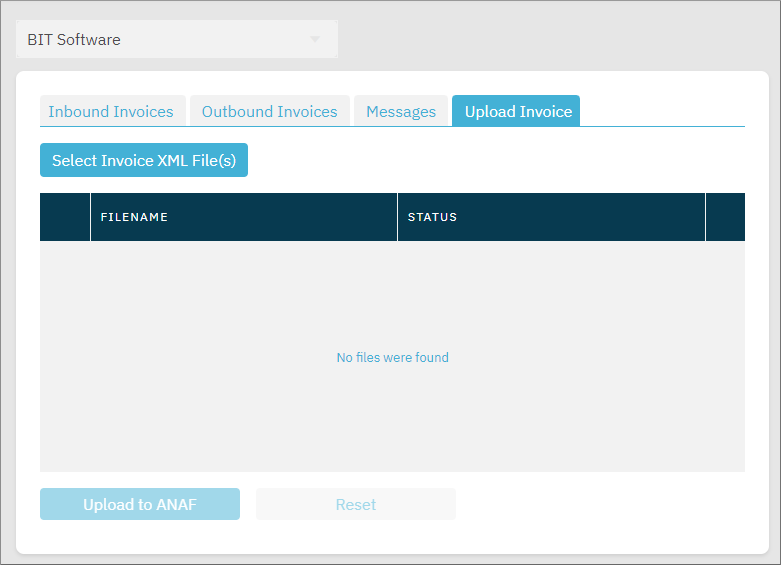
-
Click Select Invoice File(s) and browse for the XML file(s) to be uploaded from your local disk.
-
Click OK and be patient while all the files is validated against the ANAF validation API; this may take a few seconds for a small invoice. If there are validation errors, you will need to fix the reported validation errors in your invoice-generating system, re-create the invoice XML, and then try again.
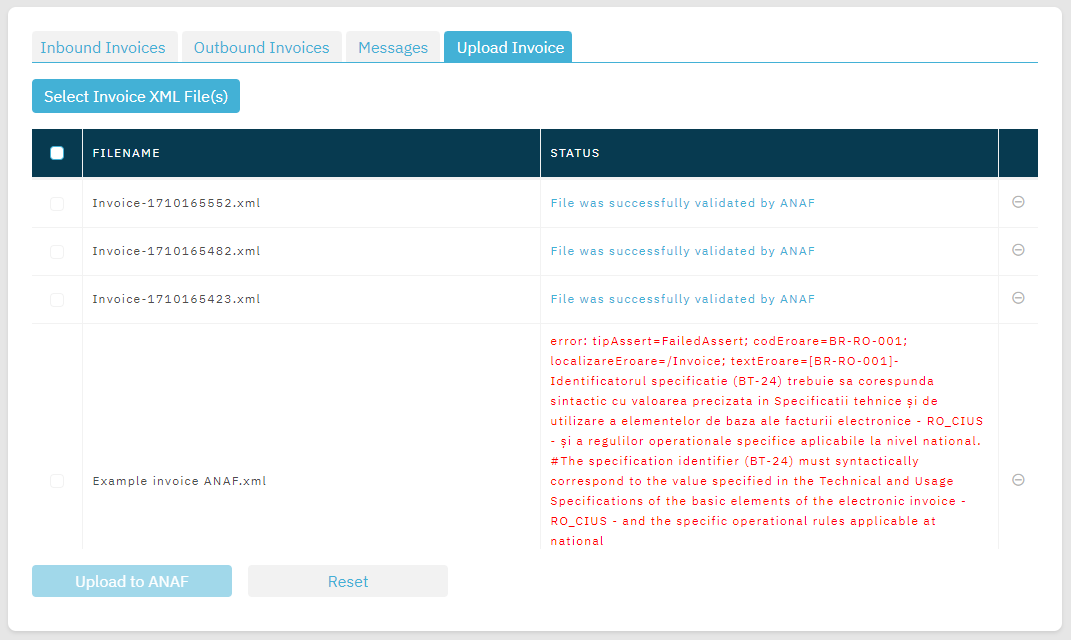
- Optionally, at this stage, you can remove any invoice from the upload batch by clicking the
 button. To remove all files and start the upload again, click Reset.
button. To remove all files and start the upload again, click Reset. - Select the invoices to be uploaded and then click Upload to ANAF. Be patient while all invoices are uploaded to ANAF; the upload outcome of each invoice is displayed as soon as it becomes available.
A successfully uploaded invoice gets the status “Uploaded to ANAF” and a unique request ID. You can use the request ID of each invoice to view its final status, which may be either REJECTED or SIGNED. Make sure to allow approximately 5 minutes from the moment when the invoice was uploaded until you check its final status. To view the final status of the invoice, click the Outbound Invoices tab and observe the Status column. Note that the most recently uploaded invoice is displayed at the top. To track the status of an invoice by its respective request ID, paste the request ID of the invoice you want to track in the Search box.
Upload invoices using GraphQL
To upload an invoice:
- Switch to the GraphQL interface.
- Create your invoice by running the
createInvoiceorcreateInvoiceFromXmlmutation. If there are any validation errors encountered at this stage, the invoice creation fails and the errors are reported in the response. You will need to fix all validation errors before proceeding to the next step. - Upload the invoice by running the
uploadInvoicemutation.
For examples, see the API reference to the e-Factura service.
Messages
The “Messages” tab displays a list of messages as provided by ANAF in real time. This is the same information that you see when you are signed in to ANAF Virtual Private Space (Spațiul Privat Virtual).
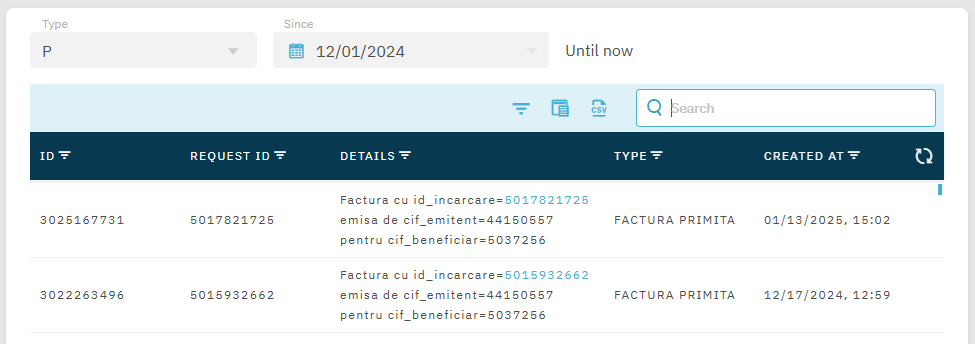
A message indicates that some event was registered by ANAF, for example:
- an invoice has been uploaded to ANAF or received from ANAF
- an invoice has been rejected by ANAF due to errors
- a notification concerning some invoice was sent or received
The “Type” column indicates the actual kind of event that took place.
By default, the grid shows messages starting with the 1st of the current month. Use the calendar picker to load earlier messages. Note, however, that you can load messages from the past 60 days only, which is the current limit set by ANAF.
To filter messages by their type, select a value from the “Type” filter at the top of the grid. Note that this filter is preselected by default to prevent unnecessary loading of large amounts of data in data-intensive environments.
The Type filter has the following possible values:
P = Invoice received T = Invoice sent R = Message sent/received E = Invoice errors
Outbound invoices
Outbound invoices are invoices issued by your organization to customers.
To view outbound invoices:
-
If applicable, select the organization from the drop-down list at the top of the page.
-
Click the Outbound Invoices tab.
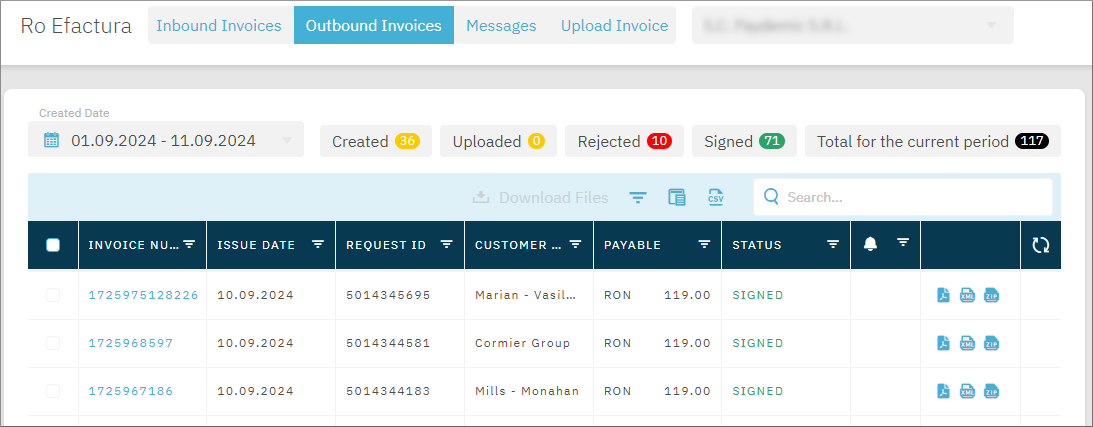
The invoices are ordered by their creation date, most recent first. To refresh the grid, click Refresh  in the top-right corner of the grid.
in the top-right corner of the grid.
By default, the following columns are available on the grid:
| Column | Purpose |
|---|---|
| Invoice number | The unique number of the invoice given at creation time. Click the invoice number to display full information about the invoice, see View outbound invoice details. |
| Issue date | The date when the invoice was issued. |
| Upload date | The date and time when the invoice was uploaded to ANAF. |
| Request ID | The identifier of the request as generated by ANAF. A request ID is available only if there was at least one attempt to upload the invoice. |
| Download ID | A download identifier as generated by ANAF. A download ID is available if the invoice was accepted (SIGNED) by ANAF. |
| Customer TIN | The customer’s tax identification number. |
| Customer name | The name of the customer on the invoice. |
| Created at | The date and time when the invoice was created in SBS. |
| Payable | The invoice payable amount (BT-115). |
| Amount | The invoice amount including tax (BT-112). This column is not displayed by default. To display it, click the the Column chooser  button on the grid and drag the Amount column from the Column Chooser onto the grid. button on the grid and drag the Amount column from the Column Chooser onto the grid. |
| Status | The invoice status. See Outbound invoice status for possible values. |
| Download buttons | An invoice may have a PDF |
Choose grid columns
Optionally, you can customize the grid to display more or less columns.
To add an extra column on the grid:
-
Click the Column chooser
 button on the grid. A Column Chooser dialog box appears:
button on the grid. A Column Chooser dialog box appears: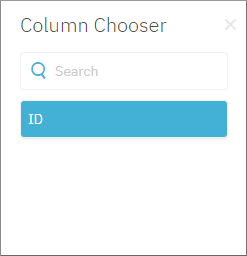
-
Drag the column of interest from the column chooser onto the grid.
Currently, the only extra column you can add to the grid is ID (the unique identifier of the invoice in SBS):
To remove a column from the grid:
- Click the Column chooser
 button on the grid.
button on the grid. - Drag a column header from the grid onto the column chooser area.
Filter outbound invoices by created date
You can filter outbound invoices by the date they were created in SBS. To do this, use the date picker available above the grid. By default, this filter is set to display all invoices starting with the 1st of the current month up to today’s date, for example:
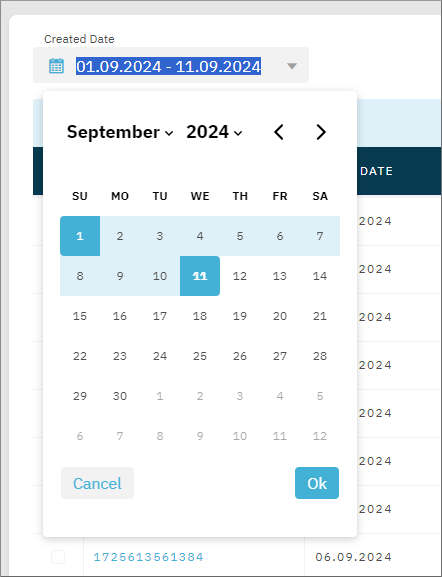
To change the date range:
- Click twice on any date except the first date of the currently visible range. A single date is selected.
- Click a date previous or subsequent to the selected date to create the range.
Filter by other criteria
To filter invoices by the values displayed in the grid, click the Filter  icon on the respective column header in the grid, for example:
icon on the respective column header in the grid, for example:
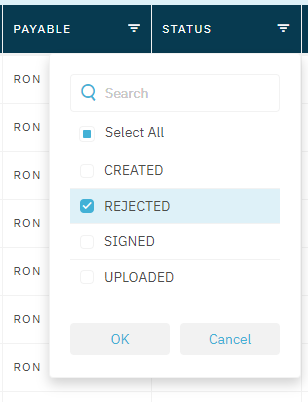
The colour of the Filter icon on each column header denotes whether the filter is active:
| Icon | Meaning |
|---|---|
 |
Filter is not active |
 |
Filter is active |
Search outbound invoices
To search outbound invoices, type your search text in the Search text box available in the right-upper corner of the grid. You can use any invoice field as search term (for example, the invoice number).
Order outbound invoices by status
To order outbound invoices by their status, click the Status column of the grid. An arrow appears in the column header indicating the sort order.
View outbound invoice details
You can view the full details available for any outbound invoice by clicking the invoice number (first column on the grid), for example:
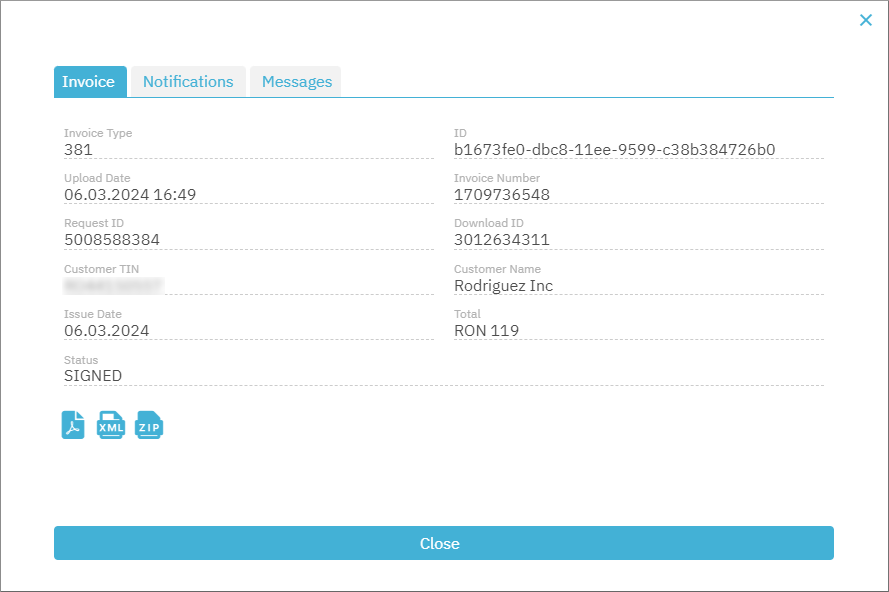
The Notifications tab displays notifications sent by the recipient of the invoice, if such exist.
The Messages tab displays the messages issued by ANAF concerning this invoice, including information messages or validation errors (if the invoice was rejected).
Outbound invoice status
The status of an outbound invoice may be one of the following:
- CREATED - the invoice has been created but not uploaded yet to ANAF. You may see this status, for example, if the invoice was created by an API call.
- UPLOADED - the invoice has been uploaded to ANAF but there is no information yet as to whether it was signed or rejected. Under normal circumstances, this status should not last more than 5 minutes. Click the Refresh
 button to obtain the latest status.
button to obtain the latest status. - SIGNED - the invoice has been accepted and signed by ANAF.
- REJECTED - the invoice has been rejected by ANAF because of validation or other errors. To view the validation errors, do any of the following:
- click the Messages tab on the Outbound invoice dialog box
- move the mouse cursor over the REJECTED stats on the grid to display validation errors as a tooltip
- download the ZIP archive and open the XML file (not the XML signature file) of the respective invoice.
Quick status statistics
For a current invoice status overview, several counters with quick statistics are available, for example:

Importantly, the counters above are reported for the time period that is currently selected from the date picker.
Query outbound invoices using GraphQL
To query invoices issued by your organization to customers:
- Switch to the GraphQL interface.
- Run the
invoicesquery.
An example is provided below.
query ListInvoices($organizationId:ID!, $filter:InvoicesFilter!) {
invoices(organizationId:$organizationId, filter:$filter) {
items {
id
organizationId
invoiceNumber
issueDate
invoiceTypeCode
status
requestId
downloadId
messages { id, creationDate, tin, requestId, details, type }
xmlFile { id downloadUrl }
pdfFile { id downloadUrl }
zipFile { id downloadUrl }
uploadedToTestEnvironment
accountingCustomerParty { partyName partyTaxScheme {companyID} }
accountingSupplierParty { partyName partyTaxScheme {companyID} }
createdAt
external
notifications { message createdAt }
}
nextToken
}
}
Make sure to replace the input variables as applicable.
{
"organizationId": "YOUR_ORGANIZATION_ID",
"filter": {
"issueDate": {
"from": "2024-01-30",
"to": "2024-01-30"
}
}
}
Inbound invoices
Inbound invoices are invoices received by your organization from suppliers.
To view inbound invoices:
-
If applicable, select the organization from the drop-down list at the top of the page.
-
Click the Inbound Invoices tab.
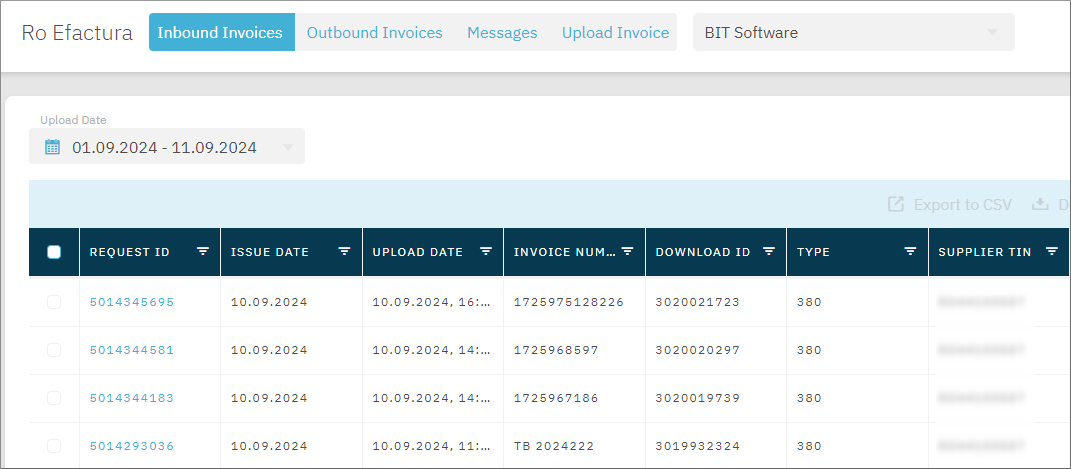
The invoices are ordered by their creation date, most recent first. To refresh the grid, click Refresh  in the top-right corner of the grid.
in the top-right corner of the grid.
The following columns are available:
| Column | Purpose |
|---|---|
| Request ID | The identifier of the request as generated by ANAF. Click the request ID to display a dialog box with all information about the invoice, see View inbound invoice details. |
| Issue date | The date when the invoice was issued. |
| Upload date | The date and time when the invoice was uploaded to ANAF. |
| Invoice number | The unique number of the invoice given at creation time. |
| Download ID | A download identifier as generated by ANAF. |
| Type | The type code of the invoice. For example, 380 - Invoice, 381 - Credit note, 389 - Autofactura. |
| Supplier TIN | The supplier’s tax identification number. |
| Supplier name | The name of the supplier. |
| Created at | The date and time when the invoice was created. |
| Amount | The total invoice amount, including VAT. |
| Download buttons | An invoice may have a PDF  is displayed, enabling you to download the respective attachments. is displayed, enabling you to download the respective attachments. |
Choose grid columns
Optionally, you can customize the grid to display more or less columns. This works in the same way as choosing grid columns for outbound invoices.
Filter inbound invoices by upload date
You can filter inbound invoices by their upload date. To do this, use the date picker available above the grid. By default, this filter is set to display all invoices where upload date starts with the 1st of the current month up to today’s date.
You can change the date range in the same way as described above for outbound invoices, see Filter outbound invoices.
Search inbound invoices
To search inbound invoices, type your search text in the Search text box available in the right-upper corner of the grid. You can use any invoice field as search term (for example, the invoice number).
View inbound invoice details
You can view the full details available for any inbound invoice by clicking the request ID of the invoice (first column on the grid).
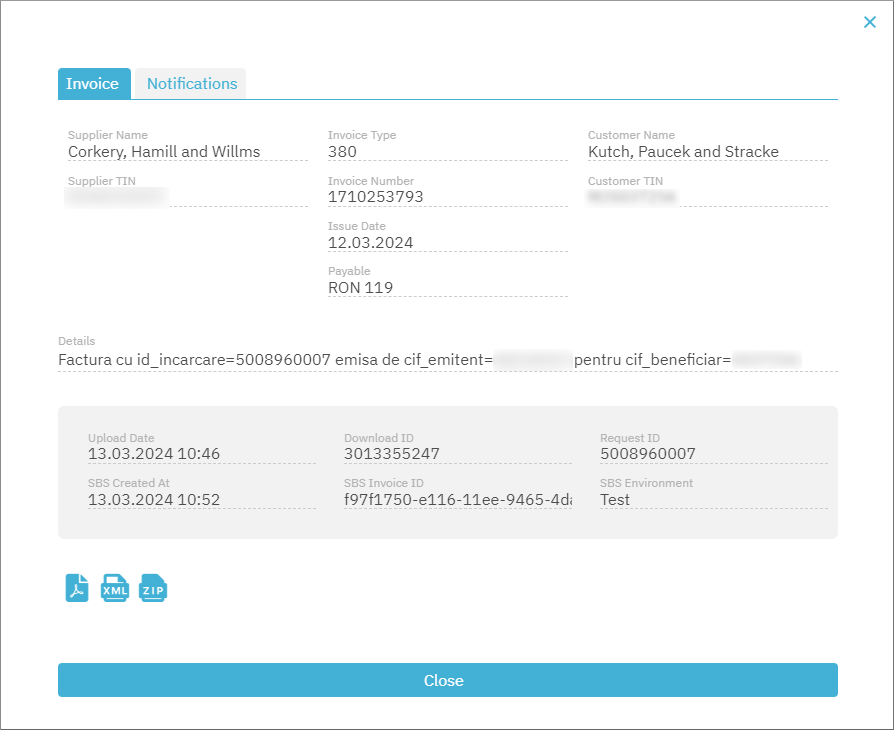
The Notifications tab enables you to send notifications to the recipient of the invoice.
Notify invoice sender
For any inbound invoices, you can send an official text notification (tracked through ANAF systems) to the invoice issuer, as follows:
- Click the first column on the grid to open the details dialog box of the respective invoice.
- Click the Notifications tab.
- Click Add
 .
. - Enter the text of the notification and click Send. Note that the text of the notification must not exceed 4000 characters.
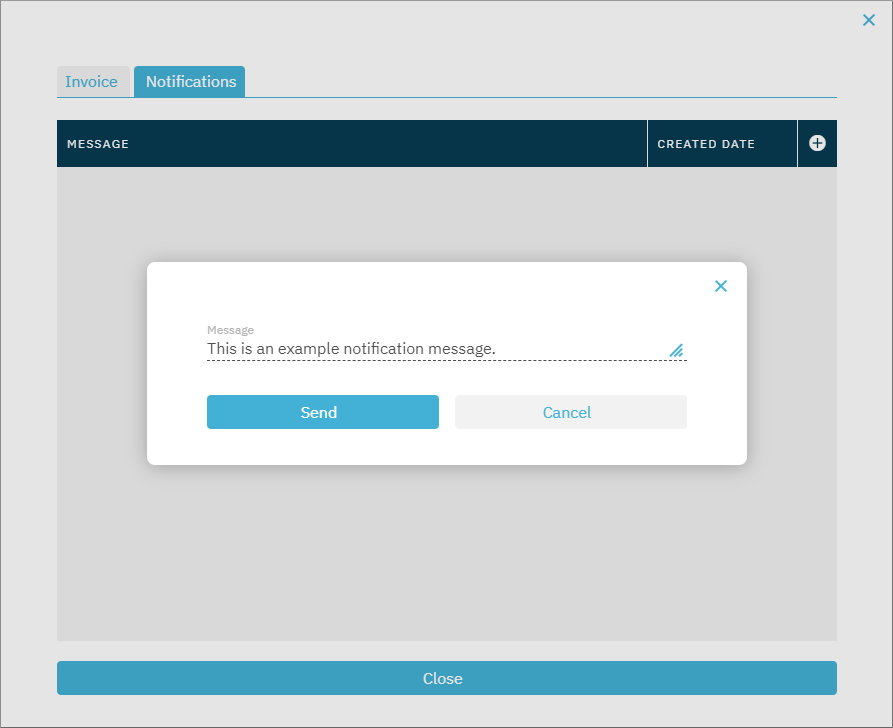
For information about notifying an invoice issuer through the API, see the notifyInvoiceSender mutation of the e-Factura Service.
Export selected invoices to CSV
For inbound invoices, you can export invoice data to CSV format. You can choose to export to CSV either a single invoice or multiple invoices. After export, one CSV row will be created for each invoice line. Data that that is applicable to the whole invoice (such as invoice totals or address-related values) will be repeated for each line.
To export invoice data to CSV:
- Select from the grid all the invoices whose data must be exported.
- Click Export to CSV.
If you selected multiple invoices, be patient while the CSV file is being generated and the browser completes the CSV file download. The exported CSV file includes the date and time when it was created in the file name, for example 10.04.2024 11_39 - BIT Software.csv.
The CSV file contains the following values extracted from the original XML of the invoice:
| # | CSV Column | Business Term | Path in UBL 2.1 XML invoice | Notes |
|---|---|---|---|---|
| 1 | InvoiceNo | BT-1 | /Invoice/cbc:ID or /CreditNote/cbc:ID |
|
| 2 | InvoiceDate | BT-2 | /Invoice/cbc:IssueDate or /CreditNote/cbc:IssueDate |
|
| 3 | InvoiceType | BT-3 | /Invoice/cbc:InvoiceTypeCode or /CreditNote/cbc:CreditNoteTypeCode |
|
| 4 | Currency | BT-5 | /Invoice/cbc:DocumentCurrencyCode or /CreditNote/cbc:DocumentCurrencyCode |
|
| 5 | CurrencyVAT | BT-6 | /Invoice/cbc:TaxCurrencyCode or /CreditNote/cbc:TaxCurrencyCode |
|
| 6 | DueDate | BT-9 | /Invoice/cbc:DueDate or /CreditNote/cac:PaymentMeans/cbc:PaymentDueDate |
|
| 7 | PO_Reference | BT-10 | /Invoice/cbc:BuyerReference or /CreditNote/cbc:BuyerReference |
|
| 8 | PJ_Reference | BT-11 | /Invoice/cac:ProjectReference/cbc:ID or /CreditNote/cac:AdditionalDocumentReference/cbc:ID |
|
| 9 | CT_Reference | BT-12 | /Invoice/cac:ContractDocumentReference/cbc:ID or /CreditNote/cac:ContractDocumentReference/cbc:ID |
|
| 10 | Order_Reference | BT-13 | /Invoice/cac:OrderReference/cbc:ID or /CreditNote/cac:OrderReference/cbc:ID |
|
| 11 | SO_Reference | BT-14 | /Invoice/cac:OrderReference/cbc:SalesOrderID or /CreditNote/cac:OrderReference/cbc:SalesOrderID |
|
| 12 | DN_Reference | BT-16 | /Invoice/cac:DespatchDocumentReference/cbc:ID or /CreditNote/cac:DespatchDocumentReference/cbc:ID |
|
| 13 | PaymentTerm | BT-20 | /Invoice/cac:PaymentTerms/cbc:Note or /CreditNote/cac:PaymentTerms/cbc:Note |
|
| 14 | InvoiceDescription | BT-22 | /Invoice/cbc:Note or /CreditNote/cbc:Note |
|
| 15 | OrigInvoiceNo | BT-25 | /Invoice/cac:BillingReference/cac:InvoiceDocumentReference or /CreditNote/cac:BillingReference/cac:InvoiceDocumentReference |
|
| 16 | OrigInvoiceDate | BT-26 | /Invoice/cac:BillingReference/cac:InvoiceDocumentReference/cbc:Issued or /CreditNote/cac:BillingReference/cac:InvoiceDocumentReference/cbc:Issued |
|
| 17 | BusinessPartner | BT-27 | /Invoice/cac:AccountingSupplierParty/cac:Party/cac:PartyLegalEntity/cbc:RegistrationName or /CreditNote/cac:AccountingSupplierParty/cac:Party/cac:PartyLegalEntity/cbc:RegistrationName |
|
| 18 | CommercialBP | BT-28 | /Invoice/cac:AccountingSupplierParty/cac:Party/cac:PartyName/cbc:Name or /CreditNote/cac:AccountingSupplierParty/cac:Party/cac:PartyName/cbc:Name |
|
| 19 | OrgVendorCode | BT-29 | /Invoice/cac:AccountingSupplierParty/cac:Party/cac:PartyIdentification/cbc:ID or /CreditNote/cac:AccountingSupplierParty/cac:Party/cac:PartyIdentification/cbc:ID |
|
| 20 | DUNE_ID | BT-30 | /Invoice/cac:AccountingSupplierParty/cac:Party/cac:PartyLegalEntity/cbc:CompanyID or /CreditNote/cac:AccountingSupplierParty/cac:Party/cac:PartyLegalEntity/cbc:CompanyID |
|
| 21 | TaxID | BT-31 | /Invoice/cac:AccountingSupplierParty/cac:Party/cac:PartyTaxScheme/cbc:CompanyID or /CreditNote/cac:AccountingSupplierParty/cac:Party/cac:PartyTaxScheme/cbc:CompanyID |
|
| 22 | TaxID_Commercial | BT-32 | /Invoice/cac:AccountingSupplierParty/cac:Party/cac:PartyTaxScheme/cbc:CompanyID or /CreditNote/cac:AccountingSupplierParty/cac:Party/cac:PartyTaxScheme/cbc:CompanyID |
|
| 23 | Address1 | BT-35 | /Invoice/cac:AccountingSupplierParty/cac:Party/cac:PostalAddress/cbc:StreetName or /CreditNote/cac:AccountingSupplierParty/cac:Party/cac:PostalAddress/cbc:StreetName |
|
| 24 | Address2 | BT-36 | /Invoice/cac:AccountingSupplierParty/cac:Party/cac:PostalAddress/cbc:AdditionalStreetName or /CreditNote/cac:AccountingSupplierParty/cac:Party/cac:PostalAddress/cbc:AdditionalStreetName |
|
| 25 | Address3 | BT-162 | /Invoice/cac:AccountingSupplierParty/cac:Party/cac:PostalAddress/cac:AddressLine/cbc:Line or /CreditNote/cac:AccountingSupplierParty/cac:Party/cac:PostalAddress/cac:AddressLine/cbc:Line |
|
| 26 | City | BT-37 | /Invoice/cac:AccountingSupplierParty/cac:Party/cac:PostalAddress/cbc:CityName or /CreditNote/cac:AccountingSupplierParty/cac:Party/cac:PostalAddress/cbc:CityName |
|
| 27 | PostalCode | BT-38 | /Invoice/cac:AccountingSupplierParty/cac:Party/cac:PostalAddress/cbc:PostalZone or /CreditNote/cac:AccountingSupplierParty/cac:Party/cac:PostalAddress/cbc:PostalZone |
|
| 28 | Region | BT-39 | /Invoice/cac:AccountingSupplierParty/cac:Party/cac:PostalAddress/cbc:CountrySubentity or /CreditNote/cac:AccountingSupplierParty/cac:Party/cac:PostalAddress/cbc:CountrySubentity |
|
| 29 | Country | BT-40 | /Invoice/cac:AccountingSupplierParty/cac:Party/cac:PostalAddress/cac:Country/cbc:IdentificationCode or /CreditNote/cac:AccountingSupplierParty/cac:Party/cac:PostalAddress/cac:Country/cbc:IdentificationCode |
|
| 30 | Contact | BT-41 | /Invoice/cac:AccountingSupplierParty/cac:Party/cac:Contact/cbc:Name or /CreditNote/cac:AccountingSupplierParty/cac:Party/cac:Contact/cbc:Name |
|
| 31 | Phone | BT-42 | /Invoice/cac:AccountingSupplierParty/cac:Party/cac:Contact/cbc:Telephone or /CreditNote/cac:AccountingSupplierParty/cac:Party/cac:Contact/cbc:Telephone |
|
| 32 | BT-43 | /Invoice/cac:AccountingSupplierParty/cac:Party/cac:Contact/cbc:ElectronicMail or /CreditNote/cac:AccountingSupplierParty/cac:Party/cac:Contact/cbc:ElectronicMail |
||
| 33 | OrgName | BT-44 | /Invoice/cac:AccountingCustomerParty/cac:Party/cac:PartyLegalEntity/cbc:RegistrationName or /CreditNote/cac:AccountingCustomerParty/cac:Party/cac:PartyLegalEntity/cbc:RegistrationName |
|
| 34 | CommercialOrgName | BT-45 | /Invoice/cac:AccountingCustomerParty/cac:Party/cac:PartyName/cbc:Name or /CreditNote/cac:AccountingCustomerParty/cac:Party/cac:PartyName/cbc:Name |
|
| 35 | GLN | BT-46 | /Invoice/cac:AccountingCustomerParty/cac:Party/cac:PartyIdentification/cbc:ID or /CreditNote/cac:AccountingCustomerParty/cac:Party/cac:PartyIdentification/cbc:ID |
|
| 36 | OrgTaxID | BT-47 | /Invoice/cac:AccountingCustomerParty/cac:Party/cac:PartyLegalEntity/cbc:CompanyID or /CreditNote/cac:AccountingCustomerParty/cac:Party/cac:PartyLegalEntity/cbc:CompanyID |
|
| 37 | SalesRep | BT-56 | /Invoice/cac:AccountingCustomerParty/cac:Party/cac:Contact/cbc:Name or /CreditNote/cac:AccountingCustomerParty/cac:Party/cac:Contact/cbc:Name |
|
| 38 | SalesRepEMail | BT-58 | /Invoice/cac:AccountingCustomerParty/cac:Party/cac:Contact/cbc:ElectronicMail or /CreditNote/cac:AccountingCustomerParty/cac:Party/cac:Contact/cbc:ElectronicMail |
|
| 39 | DN_GLN | BT-71 | /Invoice/cac:Delivery/cac:DeliveryLocation/cbc:ID or /CreditNote/cac:Delivery/cac:DeliveryLocation/cbc:ID |
|
| 40 | DN_Date | BT-72 | /Invoice/cac:Delivery/cbc:ActualDeliveryDate or /CreditNote/cac:Delivery/cbc:ActualDeliveryDate |
|
| 41 | PaymentType | BT-81 | /Invoice/cac:PaymentMeans/cbc:PaymentMeansCode or /CreditNote/cac:PaymentMeans/cbc:PaymentMeansCode |
This column contains the PaymentMeansCode value of the first encountered PaymentMeans. Subsequent PaymentMeans (if any) are disregarded. |
| 42 | IBAN | BT-84 | /Invoice/cac:PaymentMeans/cac:PayeeFinancialAccount or /CreditNote/cac:PaymentMeans/cac:PayeeFinancialAccount |
This column contains the PayeeFinancialAccount value of the first encountered PaymentMeans. Subsequent PaymentMeans (if any) are disregarded. |
| 43 | LineTotalAmt | BT-106 | /Invoice/cac:LegalMonetaryTotal/cbc:LineExtensionAmount or /CreditNote/cac:LegalMonetaryTotal/cbc:LineExtensionAmount |
|
| 44 | AllowanceTotalAmt | BT-107 | /Invoice/cac:LegalMonetaryTotal/cbc:AllowanceTotalAmount or /CreditNote/cac:LegalMonetaryTotal/cbc:AllowanceTotalAmount |
|
| 45 | ChargeTotalAmt | BT-108 | /Invoice/cac:LegalMonetaryTotal/cbc:ChargeTotalAmount or /CreditNote/cac:LegalMonetaryTotal/cbc:ChargeTotalAmount |
|
| 46 | NetTotalAmt | BT-109 | /Invoice/cac:LegalMonetaryTotal/cbc:TaxExclusiveAmount or /CreditNote/cac:LegalMonetaryTotal/cbc:TaxExclusiveAmount |
|
| 47 | VatTotalAmt | BT-110 | /Invoice/cac:TaxTotal/cbc:TaxAmount or /CreditNote/cac:TaxTotal/cbc:TaxAmount |
|
| 48 | RON_VatTotalAmt | BT-111 | /Invoice/cac:TaxTotal/cbc:TaxAmount or /CreditNote/cac:TaxTotal/cbc:TaxAmount |
|
| 49 | GrandTotalAmt | BT-112 | /Invoice/cac:LegalMonetaryTotal/cbc:TaxInclusiveAmount or /CreditNote/cac:LegalMonetaryTotal/cbc:TaxInclusiveAmount |
|
| 50 | PaidAmt | BT-113 | /Invoice/cac:LegalMonetaryTotal/cbc:PrepaidAmount or /CreditNote/cac:LegalMonetaryTotal/cbc:PrepaidAmount |
|
| 51 | OpenAmt | BT-115 | /Invoice/cac:LegalMonetaryTotal/cbc:PayableAmount or /CreditNote/cac:LegalMonetaryTotal/cbc:PayableAmount |
|
| 52 | LineNo | BT-126 | /Invoice/cac:InvoiceLine/cbc:ID or /CreditNote/cac:CreditNoteLine/cbc:ID |
|
| 53 | LineDescription | BT-127 | /Invoice/cac:InvoiceLine/cbc:Note or /CreditNote/cac:CreditNoteLine/cbc:Note |
|
| 54 | Qty | BT-129 | /Invoice/cac:InvoiceLine/cbc:InvoicedQuantity or /CreditNote/cac:CreditNoteLine/cbc:CreditedQuantity |
|
| 55 | UoM | BT-130 | /Invoice/cac:InvoiceLine/cbc:InvoicedQuantity/@unitCode or /CreditNote/cac:CreditNoteLine/cbc:CreditedQuantity/@unitCode |
|
| 56 | LineAmt | BT-131 | /Invoice/cac:InvoiceLine/cbc:LineExtensionAmount or /CreditNote/cac:CreditNoteLine/cbc:LineExtensionAmount |
|
| 57 | DN_Line | BT-132 | /Invoice/cac:InvoiceLine/cac:OrderLineReference/cbc:LineID or /CreditNote/cac:CreditNoteLine/cac:OrderLineReference/cbc:LineID |
|
| 58 | PriceStd | BT-146 | /Invoice/cac:InvoiceLine/cac:Price/cbc:PriceAmount or /CreditNote/cac:CreditNoteLine/cac:Price/cbc:PriceAmount |
|
| 59 | DiscountAmt | BT-147 | /Invoice/cac:InvoiceLine/cac:Price/cac:AllowanceCharge/cbc:Amount or /CreditNote/cac:CreditNoteLine/cac:Price/cac:AllowanceCharge/cbc:Amount |
|
| 60 | PriceList | BT-148 | /Invoice/cac:InvoiceLine/cac:Price/cac:AllowanceCharge/cbc:BaseAmount or /CreditNote/cac:CreditNoteLine/cac:Price/cac:AllowanceCharge/cbc:BaseAmount |
|
| 61 | LineTaxType | BT-151 | /Invoice/cac:InvoiceLine/cac:Item/cac:ClassifiedTaxCategory/cbc:ID or /CreditNote/cac:CreditNoteLine/cac:Item/cac:ClassifiedTaxCategory/cbc:ID |
|
| 62 | LinePercent | BT-152 | /Invoice/cac:InvoiceLine/cac:Item/cac:ClassifiedTaxCategory/cbc:Percent or /CreditNote/cac:CreditNoteLine/cac:Item/cac:ClassifiedTaxCategory/cbc:Percent |
|
| 63 | ItemName | BT-153 | /Invoice/cac:InvoiceLine/cac:Item/cbc:Name or /CreditNote/cac:CreditNoteLine/cac:Item/cbc:Name |
|
| 64 | ItemDescription | BT-154 | /Invoice/cac:InvoiceLine/cac:Item/cbc:Description or /CreditNote/cac:CreditNoteLine/cac:Item/cbc:Description |
|
| 65 | ItemCode | BT-155 | /Invoice/cac:InvoiceLine/cac:Item/cac:SellersItemIdentification/cbc:ID or /CreditNote/cac:CreditNoteLine/cac:Item/cac:SellersItemIdentification/cbc:ID |
|
| 66 | Item_BuyerCode | BT-156 | /Invoice/cac:InvoiceLine/cac:Item/cac:BuyersItemIdentification/cbc:ID or /CreditNote/cac:CreditNoteLine/cac:Item/cac:BuyersItemIdentification/cbc:ID |
|
| 67 | EAN | BT-157 | /Invoice/cac:InvoiceLine/cac:Item/cac:StandardItemIdentification/cbc:ID or /CreditNote/cac:CreditNoteLine/cac:Item/cac:StandardItemIdentification/cbc:ID |
|
| 68 | NC8_CPV | BT-158 | /Invoice/cac:InvoiceLine/cac:Item/cac:CommodityClassification/cbc:ItemClassificationCode or /CreditNote/cac:CreditNoteLine/cac:Item/cac:CommodityClassification/cbc:ItemClassificationCode |
This column contains the ItemClassificationCode value of the first encountered CommodityClassification. Subsequent CommodityClassification elements (if any) are disregarded. |
| 69 | OrigCountry | BT-159 | /Invoice/cac:InvoiceLine/cac:Item/cac:OriginCountry/cbc:IdentificationCode or /CreditNote/cac:CreditNoteLine/cac:Item/cac:OriginCountry/cbc:IdentificationCode |
|
| 70 | AttributeName | BT-160 | /Invoice/cac:InvoiceLine/cac:Item/cac:AdditionalItemProperty/cbc:Name or /CreditNote/cac:CreditNoteLine/cac:Item/cac:AdditionalItemProperty/cbc:Name |
If the XML invoice contains multiple AdditionalItemProperty elements, the names of each will be present in this column as a comma-separated list. |
| 71 | AttributeValue | BT-161 | /Invoice/cac:InvoiceLine/cac:Item/cac:AdditionalItemProperty/cbc:Value or /CreditNote/cac:CreditNoteLine/cac:Item/cac:AdditionalItemProperty/cbc:Value |
If the XML invoice contains multiple AdditionalItemProperty elements, the values of each will be present in this column as a comma-separated list. |
| 72 | RequestId | Not applicable | Not applicable | This column stores the request ID as provided by ANAF after the invoice upload. |
| 73 | DownloadId | Not applicable | Not applicable | This column stores the download ID as provided by ANAF after the invoice upload. |
Notes:
- For reference to the business term used in the “Business Term” column above, see the SR EN 16931-1+A1 standard, on which e-Factura reporting is based. The SR EN 16931-1+A1 standard can be acquired from the Romanian National Standardization Body (https://www.asro.ro).
Query inbound invoices using GraphQL
To query inbound invoices:
- Switch to the GraphQL interface.
- Run the
inboundInvoicesquery.
An example is provided below.
query InboundInvoices($organizationId:ID!, $filter:InboundInvoicesFilter!) {
inboundInvoices(organizationId:$organizationId,filter:$filter) {
items{
id
invoiceNumber
issueDate
invoiceTypeCode
organizationId
status
requestId
downloadId
details
uploadDate
xmlFile { id, downloadUrl }
pdfFile { id, downloadUrl }
zipFile { id, downloadUrl }
accountingCustomerParty { partyName partyTaxScheme { companyID } }
accountingSupplierParty { partyName partyTaxScheme { companyID } }
receivedFromTestEnvironment
createdAt
notifications { message createdAt }
}
}
}
Make sure to replace the input variables as applicable.
{
"organizationId": "YOUR_ORGANIZATION_ID",
"filter": {
"issueDate": {
"from": "2024-01-30",
"to": "2024-01-30"
}
}
}
Export grid data to CSV
You can export all data that is currently loaded into a grid to CSV format. This feature is applicable for all grids in the SBS Portal, including the e-Factura UI.
The exported CSV file includes all data columns. Non-data columns such as those that display buttons are not included.
To export grid data to CSV:
- Click the
 Export grid data to CSV button in the grid header. A CSV file named after the current UI and the current date and time is generated.
Export grid data to CSV button in the grid header. A CSV file named after the current UI and the current date and time is generated.
Bulk download invoices
You can export (bulk download) multiple inbound or outbound invoices to a single ZIP archive. This could be useful for invoice archiving purposes, for example.
Known issues
- The bulk download may fail with errors if invoices for a very large period of time are selected (for example, a year). For best results, it is recommended to use the Archives feature instead of bulk download.
- If invoice attachments exist, they will be exported with the generic extension
.file, not the actual file extension. The workaround to obtain the real filename is to open the XML file of the invoice and locate the filename under/Invoice/AdditionalDocumentReference/Attachment/EmbeddedDocumentBinaryObject@filename.
To bulk download invoices:
- Click Inbound Invoices (or Outbound invoices) in the top bar.
- Select the invoices you want to export. Use the calendar picker if you need to export invoices from previous months.
- Click Download Files. Be aware that this button is enabled only if there is at least one invoice selected.
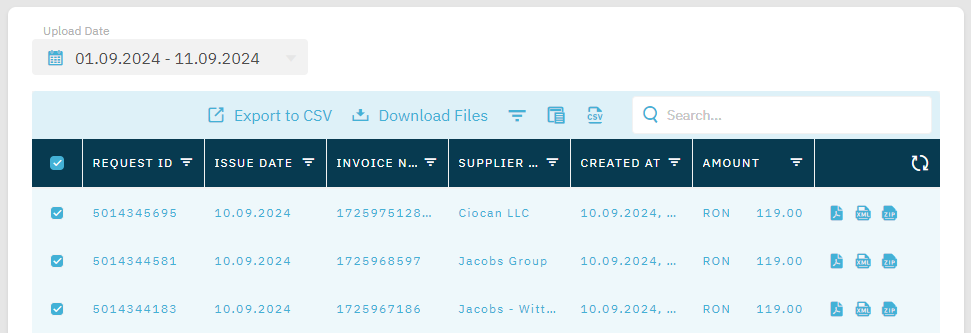
Be patient while the ZIP archive is generated. If you have selected many invoices, the export operation will take longer. A progress bar informs you of the current status while the download is in progress.
Once the download is complete, the ZIP archive is saved to a local folder, as configured in your browser settings. Alternatively, your browser may prompt you to save the ZIP archive to a directory of your choice.
The ZIP archive includes all exported invoices as folders, and is named according to the current date range selected in the UI. For example, if you exported inbound invoices from the 1st of August 2024 through 31 August 2024, the archive is named Inbound-20240801-20240831.
In case of inbound invoices, the folder of each invoice is named according to the following convention:
[Supplier Name]_[Request ID]_[Invoice Number]_[Issue date]
In case of outbound invoices, the folder of each invoice is named according to the following convention:
[Customer Name]_[Request ID]_[Invoice Number]_[Issue date]
In both cases, the issue date is in YYYY-MM-DD format.
Each invoice folder contains the following files:
- The invoice in XML format
- The invoice in PDF format
- The ZIP archive signed by ANAF
- The invoice attachment files, if such exist.
Archives
The archiving feature provides the ability to download inbound or outbound invoices between two calendar dates that you specify. Archiving takes place in the cloud and should be preferred over the bulk download feature, especially when large amount of data is involved.
An archive is a ZIP directory that contains all invoices and respective attachments within the date interval that you specify. The interval consists of a start date and and an end date.
You can create an archive for invoices of the same type (either inbound or outbound, but not both). You can also delete existing archives.
Create an archive
To create an archive:
-
Click the Archives tab.
-
Click Add
 . A dialog box pops up.
. A dialog box pops up.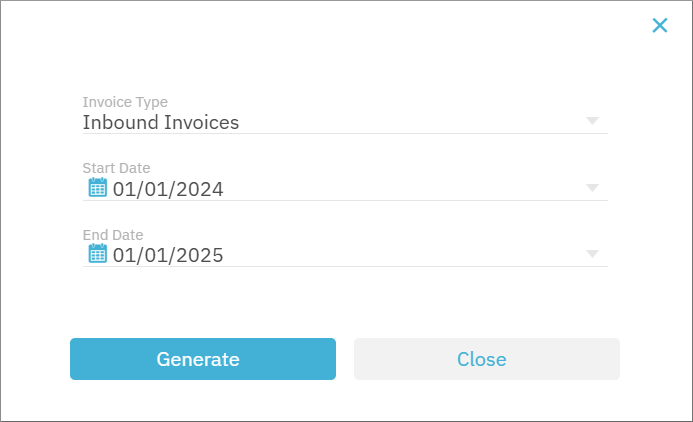
-
Select the type of invoices that you need to archive (inbound or outbound), and the start and end dates. Note that the end date should be in the past and is included in the selected date range.
-
Click Generate.
A new archive record with status NEW appears in the grid. The grid does not refresh automatically; click Refresh  to obtain the latest archive status.
to obtain the latest archive status.
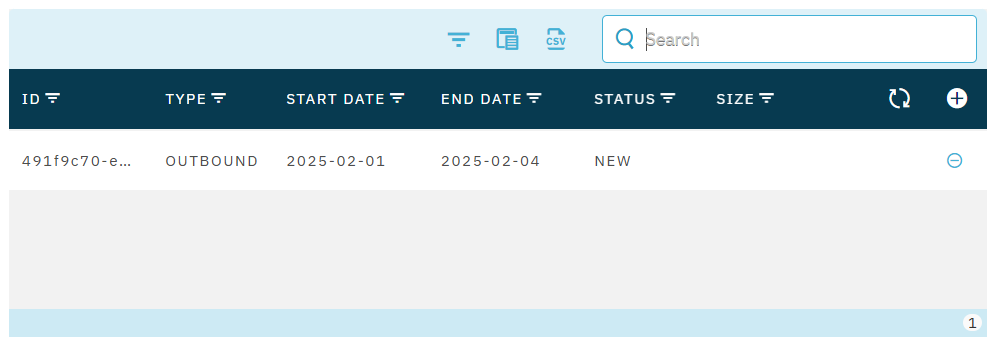
The status of the archive is initially NEW. After a few minutes, the status changes to INPROCESS. This status may last from several minutes to hours, depending on the volume of data that is being archived.
If any errors are encountered during the archiving process (for example, if no invoices exist within the specified dates), the status of the archive may change to ERROR. To view the error details, move the cursor over the word “ERROR”. The error message will be displayed as a tooltip.
If the archive generation is successful, the status becomes DONE and the archive is ready to be downloaded. Both ERROR and DONE are final statuses.
When an archive has status DONE, a ZIP download icon becomes available. Click the icon to download the generated archive file.
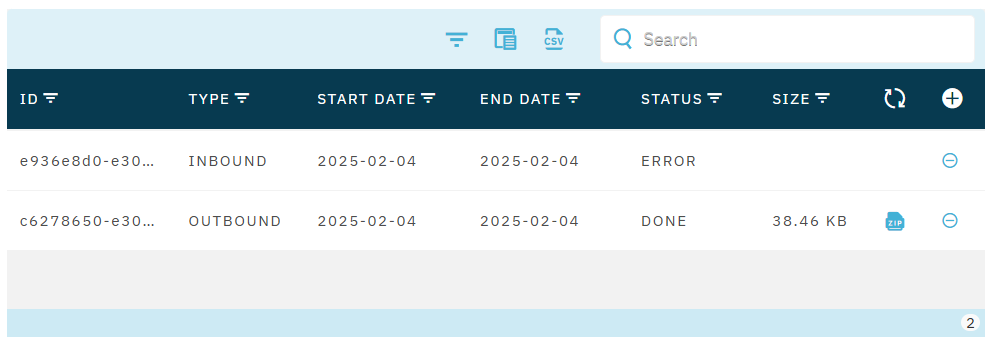
The ZIP archive is named according to the date range of the included invoices. For example, if you exported inbound invoices from the 1st of August 2024 through 31 August 2024, the archive is named OUTBOUND-2024-08-01-2024-08-31.
In case of inbound invoices, the folder of each invoice is named according to the following convention:
[Supplier Name]_[Request ID]_[Invoice Number]_[Issue date]
In case of outbound invoices, the folder of each invoice is named according to the following convention:
[Customer Name]_[Request ID]_[Invoice Number]_[Issue date]
Besides invoices, the archive may include an error log file that reports whether any invoice files or attachments could not be downloaded. In the event that you encounter such errors, you can still download the respective invoice files manually.
GraphQL
To create an archive through GraphQL, run the createArchive mutation of the e-Factura Service.